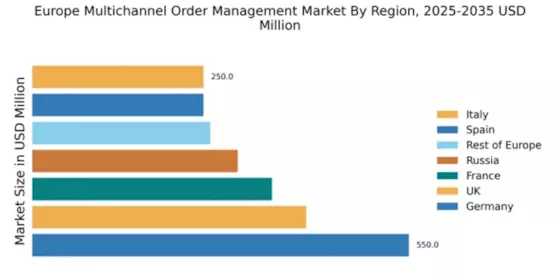Rising E-commerce Demand
The multichannel order-management market in Europe is experiencing a notable surge due to the increasing demand for e-commerce solutions. As consumers increasingly prefer online shopping, businesses are compelled to adopt multichannel strategies to meet customer expectations. In 2025, e-commerce sales in Europe are projected to reach approximately €500 billion, indicating a robust growth trajectory. This shift necessitates efficient order management systems that can seamlessly integrate various sales channels, thereby enhancing operational efficiency. Companies that invest in advanced multichannel order-management solutions are likely to gain a competitive edge, as they can better manage inventory, fulfill orders promptly, and provide a cohesive customer experience across platforms. The growing reliance on digital channels is thus a significant driver for the multichannel order-management market in Europe.
Regulatory Compliance and Standards
The multichannel order-management market in Europe is significantly impacted by the evolving landscape of regulatory compliance and standards. Businesses are increasingly required to adhere to stringent regulations regarding data protection, consumer rights, and environmental sustainability. The General Data Protection Regulation (GDPR) and other local laws necessitate that companies implement robust order-management systems that ensure compliance while maintaining customer trust. In 2025, it is anticipated that compliance-related expenditures will account for approximately 15% of total operational costs for businesses in the region. This regulatory environment compels organizations to invest in sophisticated multichannel order-management solutions that can effectively manage compliance requirements, thereby driving market growth. Adapting to these regulations is not merely a legal obligation but also a strategic advantage in building customer loyalty.
Technological Advancements in Logistics
Technological innovations in logistics are profoundly influencing the multichannel order-management market in Europe. The adoption of automation, artificial intelligence, and data analytics is transforming how businesses manage their supply chains. For instance, AI-driven tools can optimize inventory levels and predict demand fluctuations, which is crucial for effective order fulfillment. In 2025, it is estimated that logistics technology spending in Europe will exceed €100 billion, reflecting the industry's commitment to enhancing operational capabilities. These advancements enable companies to streamline their processes, reduce costs, and improve delivery times, thereby meeting the growing expectations of consumers. Consequently, the integration of cutting-edge logistics technologies serves as a vital driver for the multichannel order-management market.
Increased Focus on Supply Chain Resilience
The multichannel order-management market in Europe is being driven by an increased focus on supply chain resilience. Recent disruptions have highlighted the vulnerabilities within supply chains, prompting businesses to reassess their order-management strategies. Companies are now prioritizing systems that enhance visibility, flexibility, and responsiveness to changing market conditions. In 2025, it is projected that investments in supply chain resilience initiatives will rise by 20%, as organizations seek to mitigate risks and ensure continuity. This shift necessitates the adoption of advanced multichannel order-management solutions that can adapt to fluctuations in demand and supply. By enhancing supply chain resilience, businesses can not only improve operational efficiency but also better serve their customers, thereby driving growth in the multichannel order-management market.
Consumer Preference for Omnichannel Experiences
The shift in consumer preferences towards omnichannel shopping experiences is a critical driver for the multichannel order-management market in Europe. Customers now expect seamless interactions across various channels, including online, mobile, and in-store. This trend is prompting retailers to adopt integrated order-management systems that facilitate a unified shopping experience. Research indicates that 70% of consumers in Europe prefer brands that offer consistent experiences across all platforms. As a result, businesses are increasingly investing in multichannel order-management solutions to enhance customer satisfaction and retention. The ability to provide real-time inventory visibility and flexible fulfillment options is essential for meeting these consumer demands. Thus, the growing emphasis on omnichannel experiences is likely to propel the market forward.


















Leave a Comment